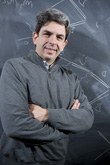Gustavo Burdman is first
Ben Lee Fellow
 |
| Gustavo Burdman |
Gustavo Burdman shares many of the interests of the late esteemed theorist Ben Lee. Burdman will get a chance to further explore those interests as the first Ben Lee Fellow.
The fellowship was created last year to commemorate a Fermilab pioneer. Lee is well-known for his work on the theory of elementary particles. He directed the laboratory's theoretical physics department from 1973 until his death in 1977. He also studied weak interactions and symmetry principles, and he had just begun a research program on cosmology before he died.
Burdman, a professor at the Physics Institute of the University of San Paulo who also holds a Guggenheim Fellowship, expects to work mainly on two issues at Fermilab: the origin of the masses of elementary particles and the nature of dark matter.
"I'm very excited about having Gustavo here," said Fermilab Deputy Director Young-Kee Kim, who helped to establish the fellowship for senior theorists, building on the Fermilab Frontier Fellowship.
Burdman started his career here as a post-doc in 1994; it's also where he met his wife, astrophysicist Ivone Albuquerque. She will work on dark matter issues at Fermilab and the Pierre Auger cosmic ray project.
Burdman looks forward to working with Fermilab's large group of theorists and expects to work closely with experimentalists. That environment owes much to the example set by Lee, who helped to bridge theory and experiment at the laboratory.
Fermilab theoretical physicist Chris Quigg, who followed Lee to Fermilab, said that "Lee has powerful gifts in all dimensions."
Lee compared his work to solving a jigsaw puzzle. He once told a group of science writers: "At moments of despair and frustration, I feel as though somebody has scrambled two boxes of jigsaw puzzles for me to put together. But I believe in what Einstein said: 'God is subtle but he is not malicious.'"
-- Kristine Crane
|